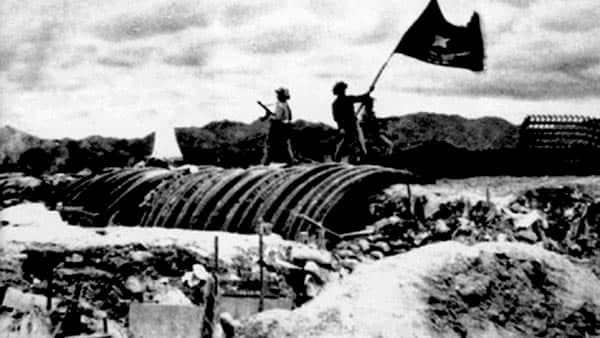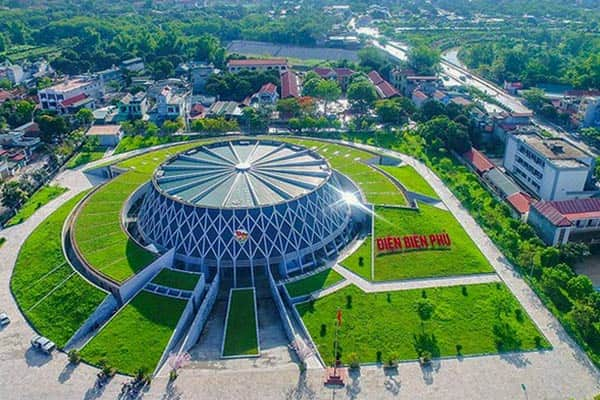DIEN BIEN PHU - NORTHERN VIETNAM
THE REMAINS OF A HISTORIC BATTLE
History of Dien Bien Phu
Indeed, Dien Bien Phu is a plain covered with fields and rice fields. The average altitude of Dien Bien Phu is 400 m. There is the small village of Dien Bien Phu and a river (Nam Youn). In addition, an old airfield built by the Japanese during the Second World War is also present on site.

Battle of Dien Bien Phu
It was on March 13 that Viet Minh took action to retake Dien Bien Phu. The attack is targeted against the "Beatrice" support point, one of the furthest from the base. The French expected this attack and its location and date thanks to the secret services, but they did not expect such firepower. In just two or three hours, thousands of heavy mortar and gun shells were sent to the position. The shelters on the spot were very quickly destroyed because they were not designed to withstand such an attack. The battalion commander and his direct deputies perished in the attack and radio communications with the base were cut off. The French artillery in charge of defending Beatrice could not accurately adjust her fire.
A Vietnamese division then advanced towards the camp, and the French soldiers on the spot, deprived of leaders and artillery support, were defeated after several hours of fighting. The centre of resistance falls in turn.
Following this day, the French realized their mistake and understood that the Viet Minh had a much higher firepower than they had expected. Colonel Charles Piroth, who had told the command that he would be able to neutralize enemy artillery, committed suicide on March 15 because of this failure.
On March 14 at around 8pm, it was the turn of the "Gabrielle" support point to be attacked. The Viet Minh used the same strategy by sending successive waves of soldiers while bombarding the position with great firepower. The French soldiers still managed to push the enemy to withdraw at 2:30 in the morning. However, the attack resumed one hour later with reinforcements and the position was abandoned by the French on the morning of 15 March.
Both sides suffered many casualties at that time. The French brought reinforcements while the Viet Minh changed strategy and sent artillerymen to bombard the main elements of the enemy base. The French landing strip was targeted, and it became unusable as of March 27. As a result, the camp can no longer receive assistance from Hanoi and the evacuation of the wounded and the receipt of supplies becomes almost impossible.
In parallel, the French are attempting several operations to establish a land link with the "Isabelle" support point to the south of the base. However, many losses are incurred during these operations. The links with Isabelle were then abandoned and this support point would fight autonomously until the end of the conflict.
From March 30 to April 4, Viet Minh targeted the hills northeast and east of the military base and seized all French support points except "Eliane 2" and "Eliane 4". The French will manage to regain 2 support points afterwards but will be forced to abandon them again. The attacks on Eliane 2 continued but were abandoned on April 4 after suffering many casualties.
Subsequently, similar attacks were carried out on other support points, particularly west of the main camp. The French will be helped by bomb-dropping planes from Hanoi, but due to lack of information and inappropriate weather conditions, in the middle of the monsoon season, the shots are not very accurate.
On the evening of May 1, the final assault was launched, the size of the main French camp having decreased significantly during the month of April. The lack of supplies and sanitary conditions in the camp are also of great concern.
On 7 May, in the face of a hopeless situation, the French command was ordered to cease firing. The remaining support points are conquered and the French base falls.
The battle of Dien Bien Phu thus represents the longest (57 days) and deadliest battle of the post-World War II era. This French defeat will also result in the acceleration of negotiations in Geneva aimed at resolving conflicts in Asia.

Museum of Victory at Dien Bien Phu
What to do in Dien Bien Phu?
Visiting
Dien Bien Phu today is mainly an opportunity to discover the remains of this
battle on site.
The
museum of the historical victory of Dien Bien Phu
This
museum has different exhibition halls with different themes. It contains
objects, photos, reconstructions and documents recounting the history and
progress of this battle. This museum is a must during your visit to Dien Bien
Phu as well as for history lovers who are embarking on a trip to Vietnam.
Colonel
de Castries' Bunker
It
was from this bunker that Colonel de Castries commanded his men. There are
still some objects from the battle as well as trenches and rooms.
Diên
Biên Phu Military Cemetery
This
is the place where the Vietnamese victims of this battle are buried. Many
Vietnamese families come to visit.
The
memorial of the French soldiers
This
memorial is located 200 m from Colonel de Castries' Bunker. This is where the
French soldiers who died during the battle are buried.



